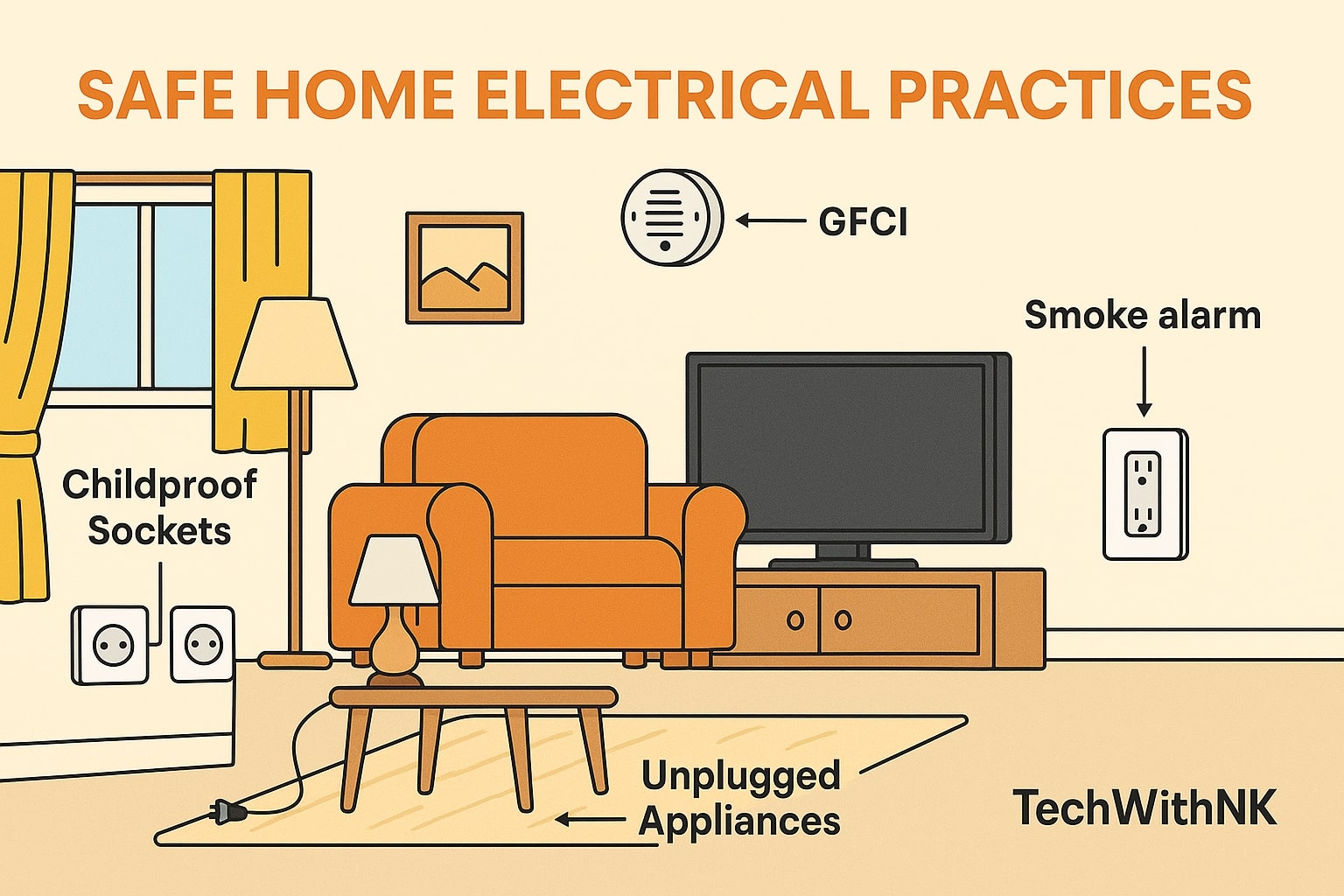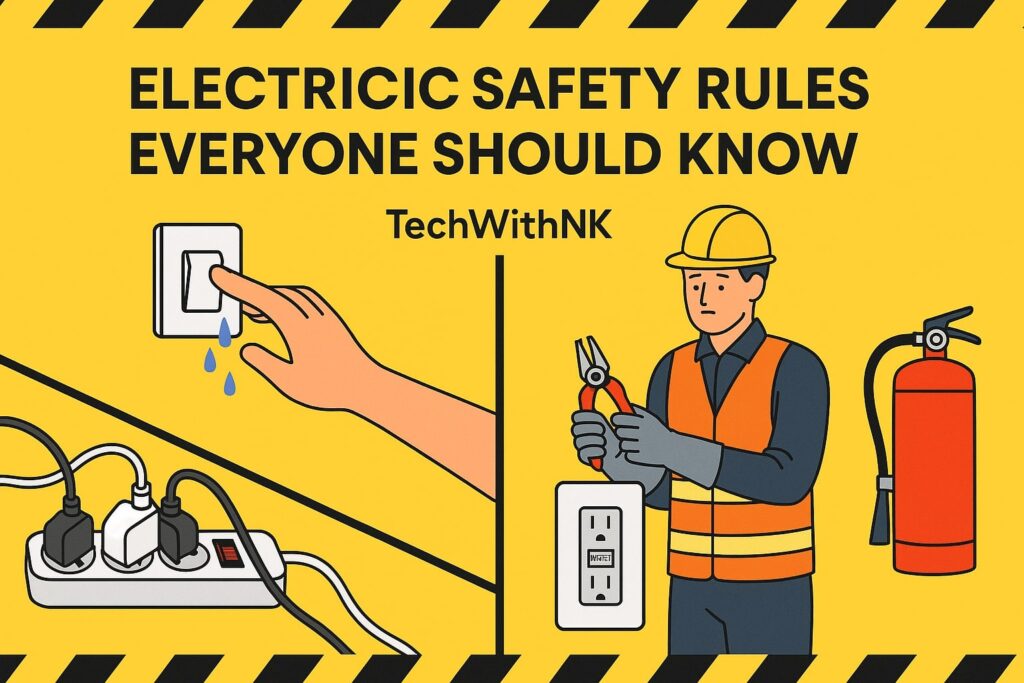Introduction
Electricity powers our modern lives—from lighting homes and running factories to fueling digital devices and medical systems. While electricity is indispensable, it is also extremely dangerous when mishandled. According to the International Labour Organization (ILO), thousands of workplace electrical accidents occur every year, with electrocution being one of the leading causes of fatalities in construction and industrial sectors.
Understanding and following electrical safety rules is not only a legal requirement but also a life-saving necessity. Whether you are a homeowner, student, electrician, or engineer, these safety rules apply universally.
In this blog, we’ll explore everything you must know about electrical safety: from the basics of safe handling, workplace practices, protective devices, common mistakes, and first aid, to national and international safety standards.
Why Electrical Safety Matters
The Dangers of Electricity
Electricity is invisible. Unlike fire or water, its danger isn’t always obvious until it strikes. Hazards include:
Electric shock – occurs when current flows through the body. Even small amounts (30 mA) can be fatal.
Burns and arc flashes – caused by short circuits or high-voltage discharges.
Fires – due to faulty wiring, overloaded circuits, or improper equipment.
Explosions – in hazardous environments like oil refineries or chemical plants.
Common Electrical Accident Statistics
Household accidents account for 70% of electrical shocks worldwide.
In India alone, over 10,000 fatalities per year are linked to electrocution (National Crime Records Bureau).
Arc flash incidents can reach 20,000 °C, hotter than the surface of the sun.
Responsibility for Electrical Safety
Individuals: safe usage at home and work.
Employers: ensuring workplace safety standards, PPE, and training.
Governments & regulators: enforcing codes like NEC (USA), IEC standards (global), and IS standards (India).
General Electrical Safety Rules
These are universal rules everyone should know and follow.
Rule 1: Always Assume Wires are Live
Never touch exposed wires.
Use a tester or multimeter before handling.
Even “dead” wires may still carry residual charge.
Rule 2: Keep Water Away from Electricity
Never operate switches with wet hands.
Avoid placing appliances near sinks or bathtubs.
Use Ground-Fault Circuit Interrupters (GFCIs) in bathrooms and kitchens.
Rule 3: Do Not Overload Circuits
Plugging too many devices into one socket can cause overheating.
Use surge protectors.
Check appliance wattage before plugging in.
Rule 4: Use the Right Fuse or Breaker
Fuses and MCBs protect against overloads.
Never replace with higher rating just to “stop tripping.”
Wrong protection may lead to fire.
Rule 5: Inspect Cords and Wires Regularly
Replace frayed, cracked, or damaged cords.
Do not run wires under carpets (hidden heating hazard).
Use proper extension cords for outdoor use.
Rule 6: Switch Off Before Working
Always switch off main power before repair or maintenance.
Use lockout/tagout (LOTO) in workplaces.
Test before you touch.
Rule 7: Use Proper Equipment
Tools should have insulated handles.
Only use certified electrical appliances.
Never DIY high-voltage repairs unless trained.
Rule 8: Wear Personal Protective Equipment (PPE)
Insulated gloves, safety shoes, arc-rated face shields.
Rubber mats in industrial environments.
Flame-retardant clothing for electricians.

Electrical Safety at Home
Childproofing
Install socket covers.
Keep appliances out of reach.
Educate children about dangers.
Appliance Safety
Unplug devices when not in use.
Do not pull cords, pull the plug.
Avoid using old or uncertified devices.
Kitchen & Bathroom Safety
Use GFCIs.
Never use heaters or hairdryers near water.
Keep wet mops away from power strips.
Fire Prevention
Smoke alarms and fire extinguishers (Class C).
Never ignore a burning smell or sparks.
Regular wiring inspection every 5–10 years.
Electrical Safety in the Workplace
Industrial Environments
Use lockout/tagout systems.
Follow OSHA and IS standards.
Train employees regularly.
Office Environments
Avoid daisy-chaining multiple extension cords.
Proper cable management to prevent tripping.
Periodic PAT (Portable Appliance Testing).
Construction Sites
Temporary wiring must be well protected.
Use RCCBs for safety.
High-visibility signs around live panels.
Protective Devices and Systems
Fuses & Circuit Breakers
Protect against overload.
MCB (Miniature Circuit Breaker).
MCCB (Molded Case Circuit Breaker).
Residual Current Devices (RCD / RCCB)
Detect leakage currents and disconnect supply.
Prevent electrocution in wet environments.
Surge Protectors & Earthing
Protect devices from lightning surges.
Earthing ensures fault current flows safely to the ground.
Arc Fault Circuit Interrupters (AFCIs)
Detect arcing faults before fires start.
First Aid in Electrical Accidents
Immediate Steps
Turn off power source.
Do not touch victim directly with bare hands.
Use wooden stick or insulated object to separate victim.
Checking the Victim
Check breathing and pulse.
If absent, perform CPR.
Call emergency services immediately.
Burns & Injuries
Cool burns with clean water.
Do not apply ointment immediately.
Cover with sterile dressing.
Common Electrical Mistakes to Avoid
Using damaged plugs.
DIY wiring without knowledge.
Ignoring tripping breakers.
Mixing water and electricity.
Forgetting to ground appliances.
Electrical Safety Standards
International Standards
NFPA 70 (NEC) – US Electrical Code.
Indian Standards
IS 732 – Code of Practice for Electrical Wiring.
CEA Regulations for power plants & industries.
Workplace Regulations
OSHA (Occupational Safety and Health Administration).
IS 5216 for safety procedures in India.
Real-Life Case Studies
Hotel Fire due to Overloaded Extension (Mumbai).
Arc Flash in a Thermal Power Plant – learning importance of PPE.
Child Shock Incident – importance of childproofing sockets.
Future of Electrical Safety
Smart IoT-enabled breakers.
AI-based fire detection.
Advanced PPE with sensors.
Smart homes with automatic cut-offs.
Conclusion
Electrical safety isn’t just about knowledge—it’s about habitual practice. Following these rules prevents accidents, saves lives, and ensures peace of mind. Remember: Electricity is a good servant but a bad master.
What are the 5 golden rules of electrical safety?
Disconnect completely.
Prevent reconnection.
Verify absence of voltage.
Ground and short-circuit.
Protect against adjacent live parts.
What PPE is required for electrical safety?
Insulated gloves, arc-rated clothing, safety shoes, face shields, and helmets.
How much current is fatal to humans?
As little as 30 mA can be fatal if it passes through the heart.











